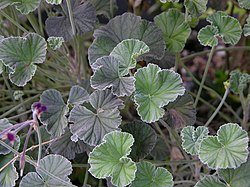| Pelargonium sidoides | |
|---|---|
 | |
| Scientific classification | |
| Kingdom: | Plantae |
| Clade: | Tracheophytes |
| Clade: | Angiosperms |
| Clade: | Eudicots |
| Clade: | Rosids |
| Order: | Geraniales |
| Family: | Geraniaceae |
| Genus: | Pelargonium |
| Species: | P. sidoides |
| Binomial name | |
| Pelargonium sidoides | |
Pelargonium sidoides is a plant native to South Africa, Eswatini, and Lesotho. Its common names include African geranium and South African geranium.
Contents
The current conservation status is Least Concern. [1]

